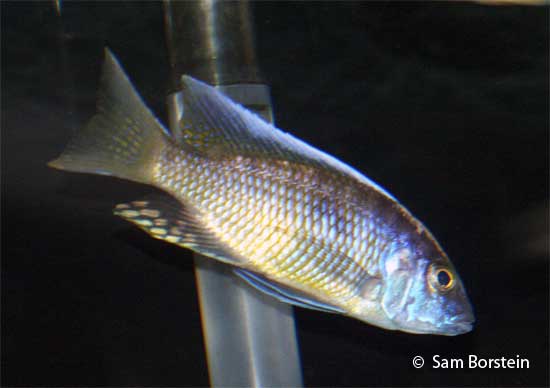Otopharynx tetraspilus
(Trewavas, 1935)
Mloto Yellow Princess
Synonyms: Haplochromis tetraspilus

Above: A male Otopharynx tetraspilus. Photo by Sam Borstein.
Etymology:
Genus- Oto= ear (Greek), pharynx= throat (Greek), referring to the head structure.
Species-tetra= four (Greek), Spilus= spot (Greek).
Intro:
Otopharynx tetraspilus was first typed by Trewavas in 1935. This Malawi hap is a maternal mouthbrooder. This fish is stunning with its golden body and blue head leading to its common name the Mloto Yellow Princess. This fish also (depending on location variant) may have a blaze in the dorsal.
Distribution:
Otopharynx tetraspilus is common in the southern part of Lake Malawi. These fish are easy to catch in the lake because they like to hide in shallow, densely planted areas.
Size, Maturity, and Sexual Dimorphism:
Size: Males- 6.5 inches, Females- 5 inches
Maturity: 3.5 inches
Sexual Dimorphism: Males are larger than females and are far more colorful than the females which are gray with 3 black dots.
Care:
The Mloto Yellow Princess is easy to care for. The fish is very peaceful and not aggressive at all. These fish are active swimmers, so a good size tank would be best. I kept a group of 4 adults in a 75. This species mixes well with other mild mannered mbuna and haps.
Diet:
Otopharynx tetraspilus is omnivorous and eats algae and crustaceans in the wild. I fed mine spectrum, Tetra Cichlid Flakes, and spirulina flakes.
Breeding:
Otopharynx tetraspilus is easy to breed. Before spawning the females get really fat and are obviously gravid. This should be your first sign. The tubes on the fish are also visible. The male when spawning becomes darker, and the blue color becomes more intense. The females are good holders and hold for about 20 days. The fry are good size and grow super fast. They are also easy to care for. These fish go crazy after water changes, so if you really want them to breed do 75% a week.
Conclusion:
This fish is rarely seen at pet shops. It is also hard to get this fish on the west coast. If you do see it available, try it. It seems to come and go in the hobby, but is never super expensive. It is a pretty fish and has a mild disposition making it a nice species to keep.
References:
- Konings, A. (2007) Malawi cichlids in their natural habitat. 4th ed., Cichlid Press, El Paso, Texas, 424 pp.
- Trewavas, E. (1935) A synopsis of the cichlid fishes of Lake Nyasa. Annals and Magazine of Natural History, 10, 65–118.
